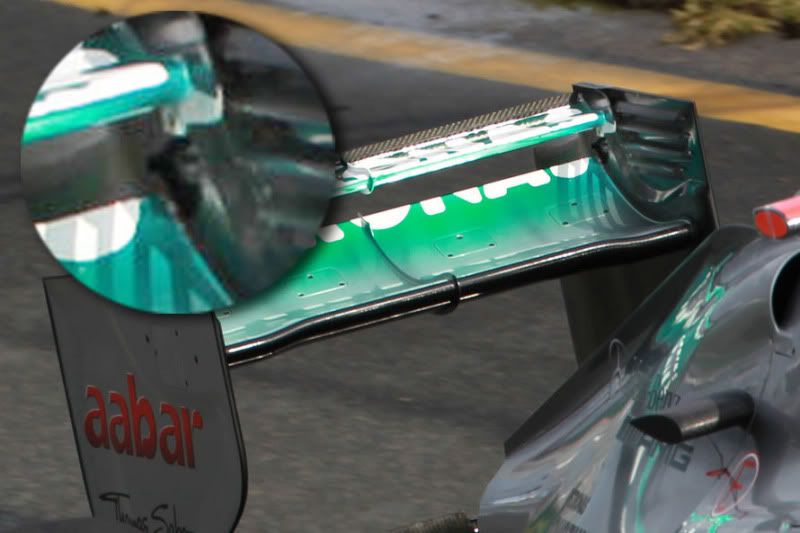- 17 Mar 12, 09:49#294690
Looking further into it, there are two possibilities if the assumption that it's an open duct that feeds air from the back to the front are correct.
The duct might be physically closed when DRS is not engaged, and the movement of the DRS wing element (or other physical parts of the system) may open the duct.
Or, the duct may be permanently open. But, when DRS is not engaged there isn't sufficient air pressure feeding into the duct to have an effect at the front of the car. But when DRS is engaged, the different airflow means that there is sufficient pressure feeding into the duct to make a difference.
We have this from Charlie Whiting.
If it was an active opening of the duct, then I can't see how CW could both say that suspension couldn't drive such a duct, but the DRS could. Note in particular CW's use of "primary purpose".
This to me suggests a permanently open duct but which is fed with low pressure when DRS is not enabled, and high pressure when DRS is open. Even if a physical movement that opens the duct was the movement of the wing element end-plate, there's no way that a duct that is physically opened by movement is "completely passive". A permanently open duct could be. Air-flow around the rear wing should change significantly when DRS is engaged making a passive duct feasible.
Edit: Are these "slots" under the front of the Mercedes wing?
http://www.suttonimages.com/searchresul ... us3467.jpg
The duct might be physically closed when DRS is not engaged, and the movement of the DRS wing element (or other physical parts of the system) may open the duct.
Or, the duct may be permanently open. But, when DRS is not engaged there isn't sufficient air pressure feeding into the duct to have an effect at the front of the car. But when DRS is engaged, the different airflow means that there is sufficient pressure feeding into the duct to make a difference.
We have this from Charlie Whiting.
"At the beginning of last year, with engineers being unable to unlearn things, they wanted to try and get the effect via different means, and they talked about opening and closing a duct by having interaction with the suspension. We said no, you cannot do that because that is not the primary purpose of the suspension system – which is to insulate the car from undulations in the road.
"There was then a lengthy discussion in the TWG at the beginning of last year about that, to make sure everyone was clear about it. It seems a couple of teams went away from that meeting with the impression that F-ducts were banned in general. Whatever an F-duct is. But they are not."
Whiting would not reveal further details of how the Mercedes system works, but said that he viewed it as completely passive.
"What it appears some teams are doing is that when the DRS is operated, it will allow air to pass into a duct and do other things," he explained.
If it was an active opening of the duct, then I can't see how CW could both say that suspension couldn't drive such a duct, but the DRS could. Note in particular CW's use of "primary purpose".
This to me suggests a permanently open duct but which is fed with low pressure when DRS is not enabled, and high pressure when DRS is open. Even if a physical movement that opens the duct was the movement of the wing element end-plate, there's no way that a duct that is physically opened by movement is "completely passive". A permanently open duct could be. Air-flow around the rear wing should change significantly when DRS is engaged making a passive duct feasible.
Edit: Are these "slots" under the front of the Mercedes wing?
http://www.suttonimages.com/searchresul ... us3467.jpg





